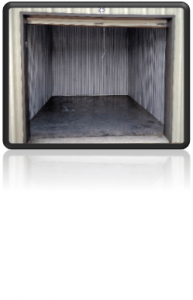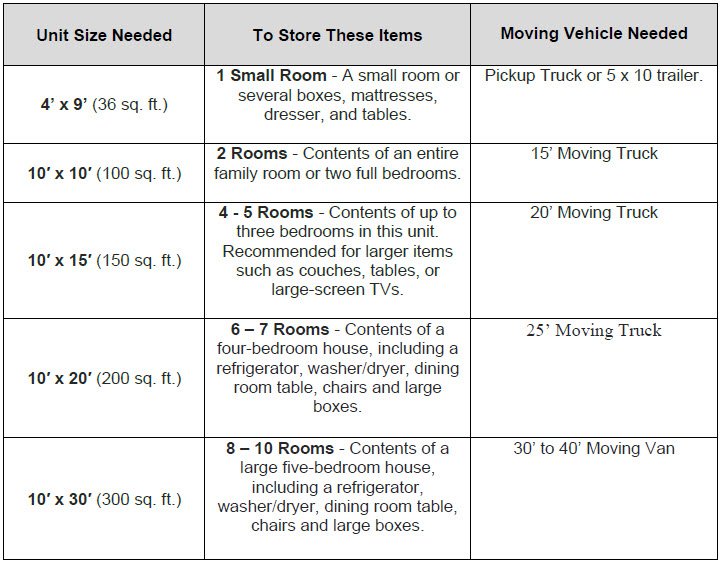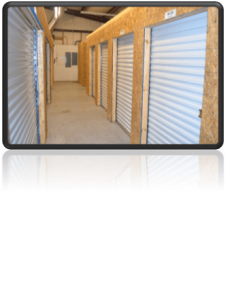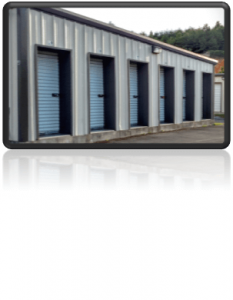So you have decided that you need to rent a self storage unit so you can store your belongings. Perhaps you are a college student needing to store your furniture for the summer, a business needing to store files, temporarily moving between apartments, or just needing to declutter the house. The Guide to Renting Self Storage is designed to answer the most common questions about renting self storage.
How do self storage leases work?
Alright, so you have probably rented an apartment before and you know these leases tend to be long-term leases of at least one year. Here’s the good news about renting self storage. Self storage leases are typically month-to-month leases. This means that you only pay for the lease one month at a time and that it can be cancelled by you (or self storage facility) prior to the beginning of the next month’s rent.
Most leases will allow you to pro-rate the rent for the month that you move-in, but you will pay for the entire month that you move out. For example, let’s say you move into your storage unit on January 15th. This means that you will pay for January 16th thru the 31st only. You don’t have to pay for the 1st thru the 15thof January. Now after you’ve had a great stay at the facility and are needing to vacate you move out on September 20th. You will owe for the entire month of September. There is no pro-rated discount for the days that you don’t use in the move-out month.
What size storage unit do I need?
 Deciding what size storage unit you are going to need to store your belongings is tough if you have never used self storage before. You want to have enough storage space to fit your items, but not excess capacity that you have to pay extra for and never use. Most storage units are listed as width x length. Ex. 10’ x 15’ unit is 150 square feet. Most units are at least 8 feet tall. We put together the Guide to Renting Self Storage infographic below to help you decide which unit will store your items comfortably without breaking the bank. It also provides a guideline for what size vehicle will be needed to transport your items to the storage facility.
Deciding what size storage unit you are going to need to store your belongings is tough if you have never used self storage before. You want to have enough storage space to fit your items, but not excess capacity that you have to pay extra for and never use. Most storage units are listed as width x length. Ex. 10’ x 15’ unit is 150 square feet. Most units are at least 8 feet tall. We put together the Guide to Renting Self Storage infographic below to help you decide which unit will store your items comfortably without breaking the bank. It also provides a guideline for what size vehicle will be needed to transport your items to the storage facility.
Check out “What Will Fit in a Storage Unit” article that provides images to give you a better idea of self storage unit sizes.

Do I need climate or non-climate storage?
 Choosing between climate or non-climate storage is mainly going to depend on what you are storing and how careful you want to be about it weathering. If you are storing fine wooden furniture, important documents, photographs, paintings, or other expensive items that are sensitive to temperature changes and moisture I recommend climate storage. It will reduce the risk of mildew, mold, and the weathering effects.
Choosing between climate or non-climate storage is mainly going to depend on what you are storing and how careful you want to be about it weathering. If you are storing fine wooden furniture, important documents, photographs, paintings, or other expensive items that are sensitive to temperature changes and moisture I recommend climate storage. It will reduce the risk of mildew, mold, and the weathering effects.
Climate storage units have the benefit of having an HVAC unit that keeps the storage facility between 60 and 80 degrees year round. Not only is the temperature constant, but HVAC unit pull the humidity out of the air which keeps moisture from building up on your personal items. This reduces the incidence of mold, mildew and weathering on sensitive items. The downside to choosing climate storage is that it is typically 50% higher in cost than a non-climate storage unit.
How do I rent self storage?
Once you decide to rent self storage there are two methods to sign up. The first is to stop by our office and sign up in person. We will require a valid driver’s license and payment for the 1st month of rent to get started. We also need your phone number, email address, and an emergency contact.
The second option is to go to one of our facility websites and sign up online. There you will create an account, make a payment via credit card, and select your storage unit. You will still need to stop by our store and sign the lease, but this will cut down on the time in the store. See the following article which shows in detail how you can sign up online at one of our 3 facilities. Click the following link to rent a storage unit at one of our 3 Cleveland TN self storage facilities. 1.) Chandler Storage-South Lee 2.) Westland Drive Storage 3). 20th Street Storage
How can I pay for self storage?
Rent for self storage is due on the 1st of each month. We give a grace period until the 5th at 5 pm prior to a late fee of $20 being charged. Most self storage facilities follow a similar policy. You can pay your rent at the office location with cash, check, money order, or credit card. A customer can call our office during office hours and pay via credit card over the phone. You also have the option to log into your personal customer account and pay via credit card from the comfort of your own home.
What lock should I use for my storage unit?
 Having a good lock is critical to the safety of your self storage belongings. We recommend choosing a facility that has a fence around the storage buildings and security cameras to deter inappropriate activity. It is also important that you limit the number of people that know that you have valuables in your unit. Oftentimes, a storage unit will be targeted by an acquaintance that is aware you have something stored in your unit that they want. However, a good lock is the last line of defense to protect your unit.
Having a good lock is critical to the safety of your self storage belongings. We recommend choosing a facility that has a fence around the storage buildings and security cameras to deter inappropriate activity. It is also important that you limit the number of people that know that you have valuables in your unit. Oftentimes, a storage unit will be targeted by an acquaintance that is aware you have something stored in your unit that they want. However, a good lock is the last line of defense to protect your unit.
There are three types of locks that are typically used when securing a storage unit; 1. Keyless lock 2. Padlock 3. Disc Lock. We recommend the disc lock to lessen the risk of tampering. These locks are harder to pick, designed for outdoor use, and are not able to be cut with bolt cutters since there is a minimal amount of hasp (“U” shaped part of lock) protruding from the lock. These locks have to be grinded off. This is a lot more work for a would-be burglar to grind off a disc lock versus moving on to a padlock that can be quickly cut off with bolt cutters. While no lock or security unit can stop a determined burglar that is willing to risk being caught, selecting a strong lock and safe facility will reduce your risk of burglary.
What hours can I access my storage unit?
The hours that you are allowed to access your storage unit will vary based on the owner operator. At our storage facilities we have the gates set to only open between the hours of 6 am to 10 pm. This is for the safety of our tenants and their storage units. We have noticed that there is more undesirable activity after 10 pm when we used to allow 24 hour access. As my mom always says, “nothing good happens after 10 pm”.
What can’t I put in a self storage unit?
A self storage tenant can store a wide variety of items in their storage unit. These include furniture, files, boxes, mattresses, bicycles, clothing, motorcycles, Christmas decorations, and many other items. A few items that we do not allow to be store in our units are combustible materials such as fireworks, gasoline, propane tanks, etc. Pets, drugs, stolen items, poisons, environmental waste are not allowed to be stored at the facility. People are also not allowed to live in the self storage facility for residential purposes.
How to Pack a Storage Unit?
Consider purchasing your boxes at a big box store such as Lowes or Home Depot or asking friends, family, or a local grocery store for free boxes.

The first thing to remember is to pack in such a way that you can find things at a later date quickly and without unloading everything in your unit in order to get a particular item out of your unit. I can’t tell you the number of times I have seen self storage tenants take an afternoon in order to get a few items out of storage. All of their belongings will be spread out in the parking lot as they try to find that one item that they can’t remember where they packed. A little prior planning goes a long way to ensure that you can quickly get to the items you need in the future. Make an inventory of what you’ve packed and where it is as you go along. Other packing and storage preparation tips include:
- Box everything that you can – everything that is left unboxed in a self storage facility will get dusty and potentially dirty.
- Fill boxes to capacity wherever possible to avoid breakages but avoid making them too heavy. You can use materials such as paper or towels or can buy special packing to fill spaces if necessary. Boxes that are only partly filled may tip over or collapse.
- Label all boxes clearly so you can identify the contents and keep an inventory. Label them on more than one side so you can see what’s what quickly. Mark ‘Fragile’ on any boxes containing breakable items.
- Don’t be tempted to fill large boxes with heavy items such as books as they are difficult to carry and may break. If you do pack heavy items in a large box put in just a few and then fill the box up with lighter items.
- Don’t store wet items in a self storage facility as they can cause water damage, mold and mildew.
- Large appliances need care before placing in a storage unit. Make sure you defrost fridges and freezers thoroughly before storing them otherwise you’ll be leaving yourself open to water damage. Leave the doors slightly ajar once in storage to stop condensation forming causing mildew and smells. Drain washing machines before storing them and tie down hoses. Appliances should be clean and dry.
- Wrap all fragile items and breakables such as dishes, glasses, ornaments separately. Paper works for wrapping items, but bubble wrap is better. Pack them tightly into strong boxes, filling any gaps with paper. Try to avoid putting heavy items on top of fragile ones in your unit.
- If you’re storing mattresses and couches in a self storage facility consider investing in covers, bags or sheeting to give them some additional protection. Stand sofas and mattresses on end wherever possible to save space and don’t stack too much on top of soft furnishings.
- You can save space if you can dismantle furniture such as beds and tables before you store it. Make sure you keep all the parts and screws so you can put it all back together again. Wrap and cover furniture sections and keep them together, for quick retrieval. You can put components such as screws and bolts together in a plastic bag, mark them clearly and tape to the relevant piece of furniture. Store large pieces of furniture vertically to save space in the facility.
How do I vacate a storage unit?
So you are nearing the end of your time needing a self storage unit and you want to make sure you leave on good terms and not incur any additional charges. First off, check the contract with your storage provider and give them a call just to confirm the steps you will need to take to avoid any cleaning fees or additional months rent due to not providing enough move-out notice.
- At Chandler Properties we request a notice of 7 days prior to the beginning of the next month as notice. You will need to vacate the unit prior to the 1st of the following month to avoid paying rent for the next month. Other storage operators may have different policies so it is a good idea to check with them prior to moving out just to make sure you comply with their policies.
- Remove all contents, not leaving anything behind, and sweep the unit clean.
- Remove your lock. If there is still a lock on the unit, we can’t re-rent the unit.
- Call or email us to confirm that you have moved out.
I hope the Guide to Renting Self Storage was helpful in answering your questions about self storage. If you like it, please “Like” our Facebook page or our website. You can also contact us via telephone at 423-614-0069. Chandler Properties provides residential and self storage in Cleveland TN.


